Page 1274 of 3383
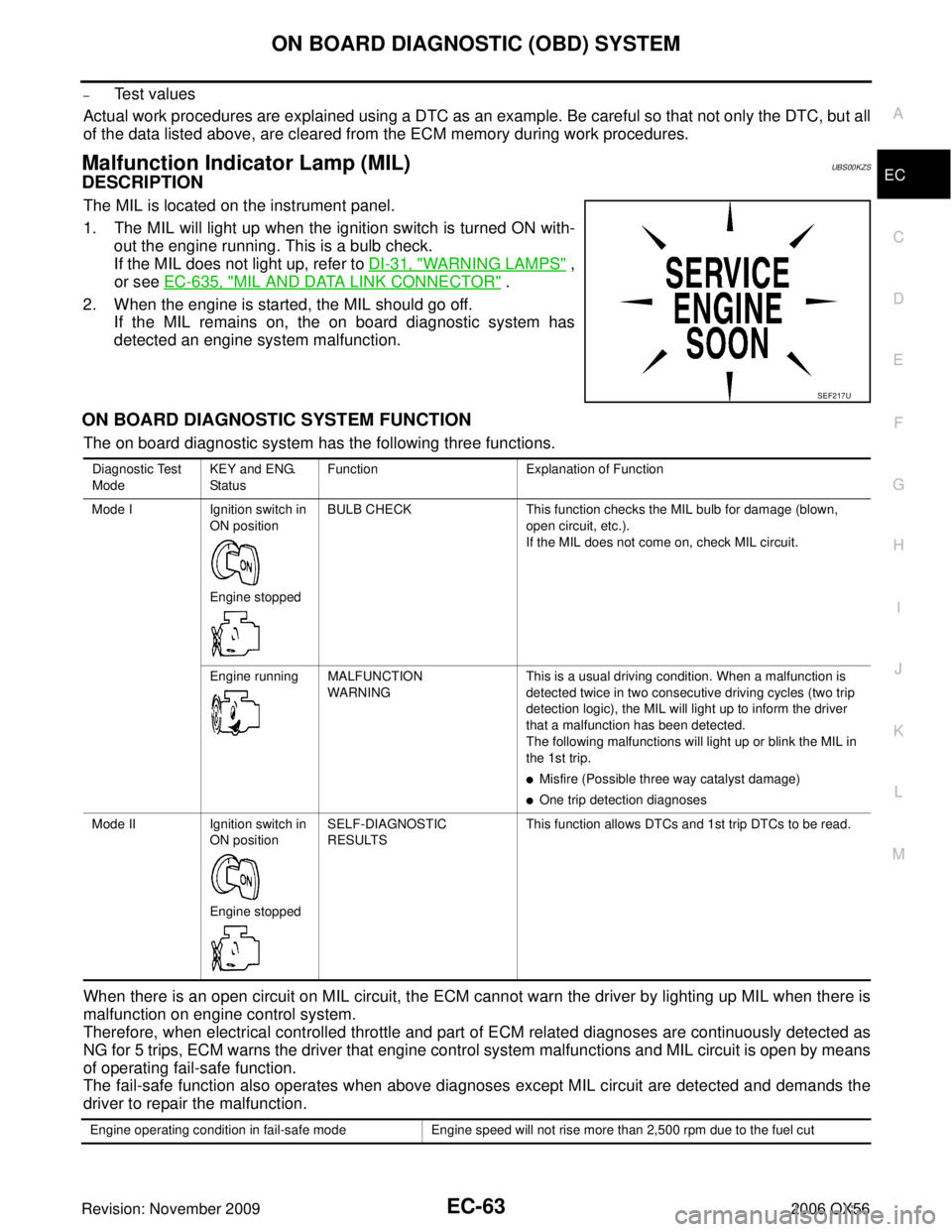
ON BOARD DIAGNOSTIC (OBD) SYSTEMEC-63
C
DE
F
G H
I
J
K L
M A
EC
Revision: November 2009 2006 QX56
–Test values
Actual work procedures are explained using a DTC as an example. Be careful so that not only the DTC, but all
of the data listed above, are cleared from the ECM memory during work procedures.
Malfunction Indicator Lamp (MIL)UBS00KZS
DESCRIPTION
The MIL is located on the instrument panel.
1. The MIL will light up when the ignition switch is turned ON with- out the engine running. This is a bulb check.
If the MIL does not light up, refer to DI-31, "
WARNING LAMPS" ,
or see EC-635, "
MIL AND DATA LINK CONNECTOR" .
2. When the engine is started, the MIL should go off. If the MIL remains on, the on board diagnostic system has
detected an engine system malfunction.
ON BOARD DIAGNOSTIC SYSTEM FUNCTION
The on board diagnostic system has the following three functions.
When there is an open circuit on MIL circuit, the ECM cannot warn the driver by lighting up MIL when there is
malfunction on engine control system.
Therefore, when electrical controlled throttle and part of ECM related diagnoses are continuously detected as
NG for 5 trips, ECM warns the driver that engine control system malfunctions and MIL circuit is open by means
of operating fail-safe function.
The fail-safe function also operates when above diagnoses except MIL circuit are detected and demands the
driver to repair the malfunction.
SEF217U
Diagnostic Test
Mode KEY and ENG.
StatusFunction
Explanation of Function
Mode I Ignition switch in
ON position
Engine stopped BULB CHECK
This function checks the MIL bulb for damage (blown,
open circuit, etc.).
If the MIL does not come on, check MIL circuit.
Engine running MALFUNCTION WARNING This is a usual driving condition. When a malfunction is
detected twice in two consecutive driving cycles (two trip
detection logic), the MIL will light up to inform the driver
that a malfunction has been detected.
The following malfunctions will light up or blink the MIL in
the 1st trip.
�Misfire (Possible three way catalyst damage)
�One trip detection diagnoses
Mode II Ignition switch in
ON position
Engine stopped SELF-DIAGNOSTIC
RESULTS
This function allows DTCs and 1st trip DTCs to be read.
Engine operating condition in fail-safe mode
Engine speed will not rise more than 2,500 rpm due to the fuel cut
Page 1278 of 3383
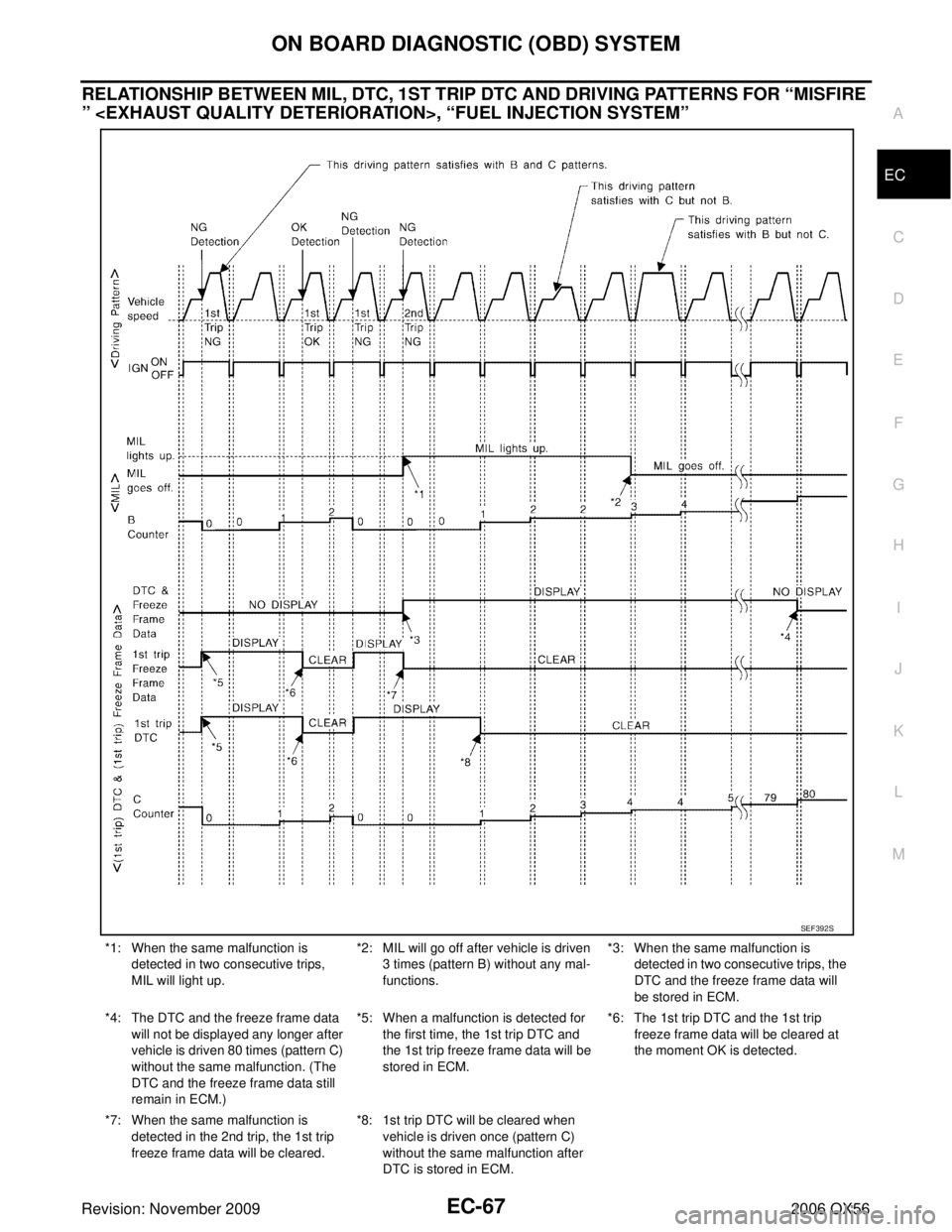
ON BOARD DIAGNOSTIC (OBD) SYSTEMEC-67
C
DE
F
G H
I
J
K L
M A
EC
Revision: November 2009 2006 QX56
RELATIONSHIP BETWEEN MIL, DTC, 1ST TRIP DTC AND DRIVING PATTERNS FOR “MISFIRE
” , “FUEL INJECTION SYSTEM”
*1: When the same malfunction is
detected in two consecutive trips,
MIL will light up. *2: MIL will go off after vehicle is driven
3 times (pattern B) without any mal-
functions. *3: When the same malfunction is
detected in two consecutive trips, the
DTC and the freeze frame data will
be stored in ECM.
*4: The DTC and the freeze frame data will not be displayed any longer after
vehicle is driven 80 times (pattern C)
without the same malfunction. (The
DTC and the freeze frame data still
remain in ECM.) *5: When a malfunction is detected for
the first time, the 1st trip DTC and
the 1st trip freeze frame data will be
stored in ECM. *6: The 1st trip DTC and the 1st trip
freeze frame data will be cleared at
the moment OK is detected.
*7: When the same malfunction is detected in the 2nd trip, the 1st trip
freeze frame data will be cleared. *8: 1st trip DTC will be cleared when
vehicle is driven once (pattern C)
without the same malfunction after
DTC is stored in ECM.
SEF392S
Page 1280 of 3383
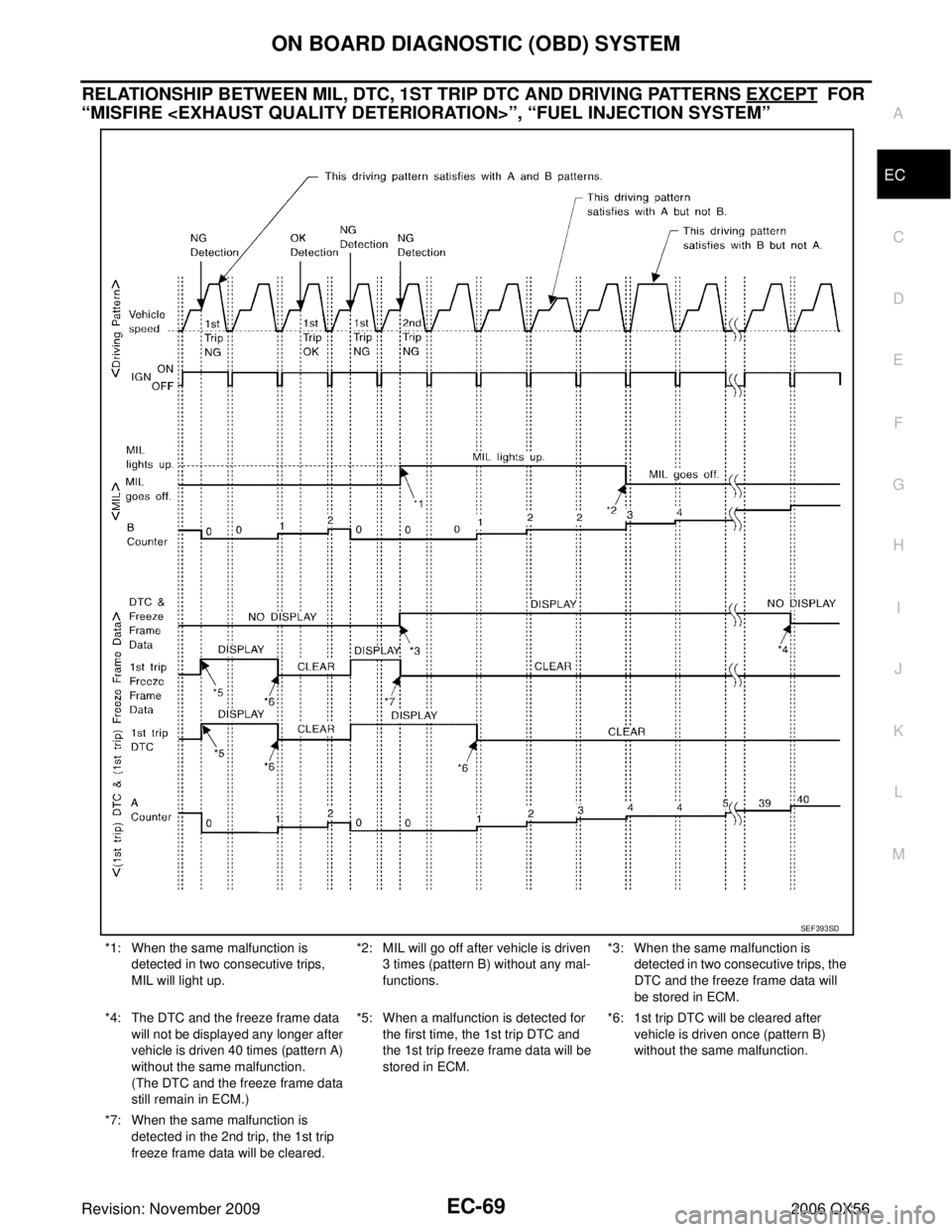
ON BOARD DIAGNOSTIC (OBD) SYSTEMEC-69
C
DE
F
G H
I
J
K L
M A
EC
Revision: November 2009 2006 QX56
RELATIONSHIP BETWEEN MIL, DTC, 1ST TRIP DTC AND DRIVING PATTERNS EXCEPT FOR
“MISFIRE ”, “FUEL INJECTION SYSTEM”
*1: When the same malfunction is
detected in two consecutive trips,
MIL will light up. *2: MIL will go off after vehicle is driven
3 times (pattern B) without any mal-
functions. *3: When the same malfunction is
detected in two consecutive trips, the
DTC and the freeze frame data will
be stored in ECM.
*4: The DTC and the freeze frame data will not be displayed any longer after
vehicle is driven 40 times (pattern A)
without the same malfunction.
(The DTC and the freeze frame data
still remain in ECM.) *5: When a malfunction is detected for
the first time, the 1st trip DTC and
the 1st trip freeze frame data will be
stored in ECM. *6: 1st trip DTC will be cleared after
vehicle is driven once (pattern B)
without the same malfunction.
*7: When the same malfunction is detected in the 2nd trip, the 1st trip
freeze frame data will be cleared.
SEF393SD
Page 1285 of 3383
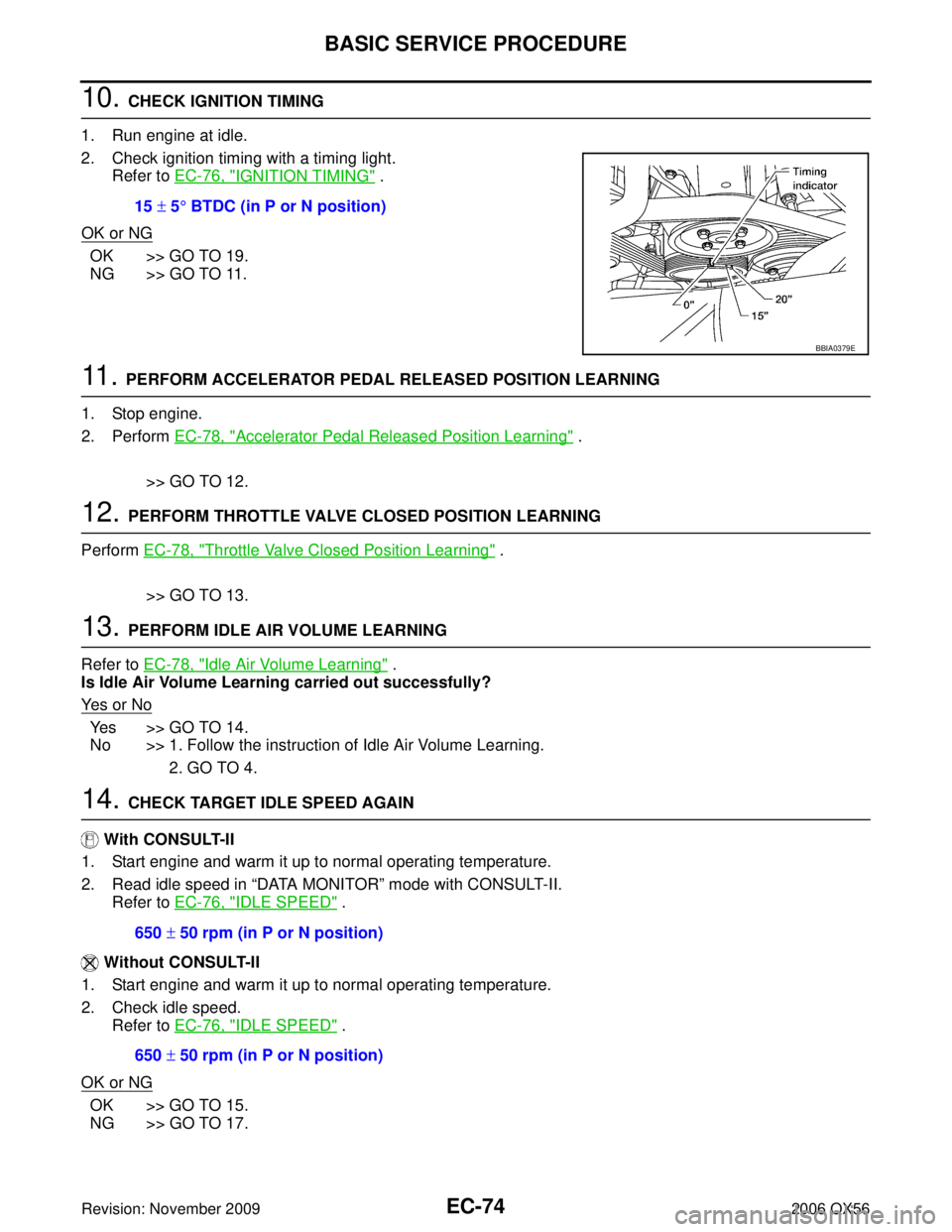
EC-74Revision: November 2009
BASIC SERVICE PROCEDURE
2006 QX56
10. CHECK IGNITION TIMING
1. Run engine at idle.
2. Check ignition timing with a timing light. Refer to EC-76, "
IGNITION TIMING" .
OK or NG
OK >> GO TO 19.
NG >> GO TO 11.
11 . PERFORM ACCELERATOR PEDAL RELEASED POSITION LEARNING
1. Stop engine.
2. Perform EC-78, "
Accelerator Pedal Released Position Learning" .
>> GO TO 12.
12. PERFORM THROTTLE VALVE CLOSED POSITION LEARNING
Perform EC-78, "
Throttle Valve Closed Position Learning" .
>> GO TO 13.
13. PERFORM IDLE AIR VOLUME LEARNING
Refer to EC-78, "
Idle Air Volume Learning" .
Is Idle Air Volume Learning carried out successfully?
Ye s o r N o
Yes >> GO TO 14.
No >> 1. Follow the instruction of Idle Air Volume Learning.
2. GO TO 4.
14. CHECK TARGET IDLE SPEED AGAIN
With CONSULT-II
1. Start engine and warm it up to normal operating temperature.
2. Read idle speed in “DATA MONITOR” mode with CONSULT-II.
Refer to EC-76, "
IDLE SPEED" .
Without CONSULT-II
1. Start engine and warm it up to normal operating temperature.
2. Check idle speed. Refer to EC-76, "
IDLE SPEED" .
OK or NG
OK >> GO TO 15.
NG >> GO TO 17. 15
± 5 ° BTDC (in P or N position)
BBIA0379E
650 ± 50 rpm (in P or N position)
650 ± 50 rpm (in P or N position)
Page 1286 of 3383
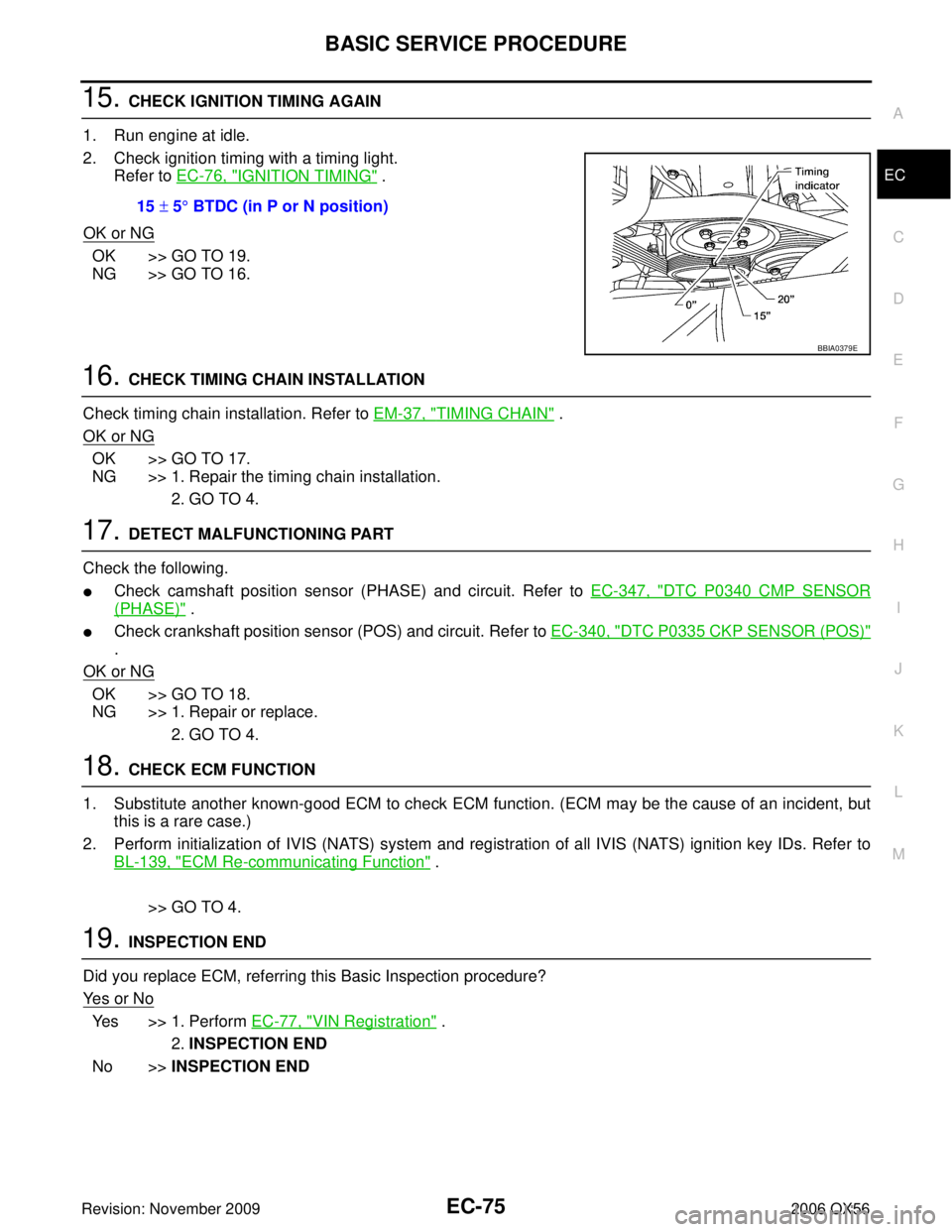
BASIC SERVICE PROCEDUREEC-75
C
DE
F
G H
I
J
K L
M A
EC
Revision: November 2009 2006 QX56
15. CHECK IGNITION TIMING AGAIN
1. Run engine at idle.
2. Check ignition timing with a timing light. Refer to EC-76, "
IGNITION TIMING" .
OK or NG
OK >> GO TO 19.
NG >> GO TO 16.
16. CHECK TIMING CHAIN INSTALLATION
Check timing chain installation. Refer to EM-37, "
TIMING CHAIN" .
OK or NG
OK >> GO TO 17.
NG >> 1. Repair the timing chain installation. 2. GO TO 4.
17. DETECT MALFUNCTIONING PART
Check the following.
�Check camshaft position sensor (PHASE) and circuit. Refer to EC-347, "DTC P0340 CMP SENSOR
(PHASE)" .
�Check crankshaft position sensor (POS) and circuit. Refer to EC-340, "DTC P0335 CKP SENSOR (POS)"
.
OK or NG
OK >> GO TO 18.
NG >> 1. Repair or replace. 2. GO TO 4.
18. CHECK ECM FUNCTION
1. Substitute another known-good ECM to check ECM function. (ECM may be the cause of an incident, but this is a rare case.)
2. Perform initialization of IVIS (NATS) system and registration of all IVIS (NATS) ignition key IDs. Refer to BL-139, "
ECM Re-communicating Function" .
>> GO TO 4.
19. INSPECTION END
Did you replace ECM, referring this Basic Inspection procedure?
Ye s o r N o
Ye s > > 1 . P e r f o r m EC-77, "VIN Registration" .
2. INSPECTION END
No >> INSPECTION END
15
± 5 ° BTDC (in P or N position)
BBIA0379E
Page 1287 of 3383
EC-76Revision: November 2009
BASIC SERVICE PROCEDURE
2006 QX56
Idle Speed and Ignition Timing CheckUBS00KZV
IDLE SPEED With CONSULT-II
Check idle speed in “DATA MONITOR” mode with CONSULT-II.
With GST
Check idle speed with GST.
IGNITION TIMING
Any of following two methods may be used.
Method A
1. Attach timing light to loop wire as shown.
2. Check ignition timing.
Method B
1. Remove ignition coil No.1.
SEF058Y
BBIA0377E
BBIA0379E
BBIA0360E
Page 1288 of 3383
BASIC SERVICE PROCEDUREEC-77
C
DE
F
G H
I
J
K L
M A
EC
Revision: November 2009 2006 QX56
2. Connect ignition coil No.1 and spark plug with suitable high-ten-
sion wire as shown, and attach timing light clamp to this wire.
3. Check ignition timing.
VIN RegistrationUBS00KZX
DESCRIPTION
VIN Registration is an operation to registering VIN in ECM. It must be performed each time ECM is replaced.
NOTE:
Accurate VIN which is registered in ECM may be required for Inspection & Maintenance (I/M).
OPERATION PROCEDURE With CONSULT-II
1. Check the VIN of the vehicle and note it. Refer to GI-47, "IDENTIFICATION INFORMATION" .
2. Turn ignition switch ON and engine stopped.
3. Select “VIN REGISTRATION ” in “WORK SUPPORT ” mode.
4. Follow the instruction of CONSULT-II display.
BBIA0378E
SEF011V
BBIA0379E
PBIB2242E
Page 1289 of 3383

EC-78Revision: November 2009
BASIC SERVICE PROCEDURE
2006 QX56
Accelerator Pedal Released Position LearningUBS00KZY
DESCRIPTION
Accelerator Pedal Released Position Learning is an operation to learn the fully released position of the accel-
erator pedal by monitoring the accelerator pedal position sensor output signal. It must be performed each time
harness connector of accelerator pedal position sensor or ECM is disconnected.
OPERATION PROCEDURE
1. Make sure that accelerator pedal is fully released.
2. Turn ignition switch ON and wait at least 2 seconds.
3. Turn ignition switch OFF and wait at least 10 seconds.
4. Turn ignition switch ON and wait at least 2 seconds.
5. Turn ignition switch OFF and wait at least 10 seconds.
Throttle Valve Closed Position LearningUBS00KZZ
DESCRIPTION
Throttle Valve Closed Position Learning is an operation to learn the fully closed position of the throttle valve by
monitoring the throttle position sensor output signal. It must be performed each time harness connector of
electric throttle control actuator or ECM is disconnected.
OPERATION PROCEDURE
1. Make sure that accelerator pedal is fully released.
2. Turn ignition switch ON.
3. Turn ignition switch OFF wait at least 10 seconds.Make sure that throttle valve moves during above 10 seconds by confirming the operating sound.
Idle Air Volume LearningUBS00L00
DESCRIPTION
Idle Air Volume Learning is an operation to learn the idle air volume that keeps each engine within the specific
range. It must be performed under any of the following conditions:
�Each time electric throttle control actuator or ECM is replaced.
�Idle speed or ignition timing is out of specification.
PREPARATION
Before performing Idle Air Volume Learning, make sure that all of the following conditions are satisfied.
Learning will be cancelled if any of the following conditions are missed for even a moment.
�Battery voltage: More than 12.9V (At idle)
�Engine coolant temperature: 70 - 100 °C (158 - 212 °F)
�Park/Neutral position (PNP) switch: ON
�Electric load switch: OFF
(Air conditioner, headlamp, rear window defogger)
On vehicles equipped with daytime light systems, if the parking brake is applied before the engine
is start the headlamp will not be illuminated.
�Steering wheel: Neutral (Straight-ahead position)
�Vehicle speed: Stopped
�Transmission: Warmed-up
–With CONSULT-II: Drive vehicle until “ATF TEMP SE 1 ” in “DATA MONITOR” mode of “A/T” system indi-
cates less than 0.9V.
–Without CONSULT-II: Drive vehicle for 10 minutes.
OPERATION PROCEDURE
With CONSULT-II
1. Perform EC-78, "Accelerator Pedal Released Position Learning" .
2. Perform EC-78, "
Throttle Valve Closed Position Learning" .
3. Start engine and warm it up to normal operating temperature.
4. Check that all items listed under the topic PREPARATION (previously mentioned) are in good order.